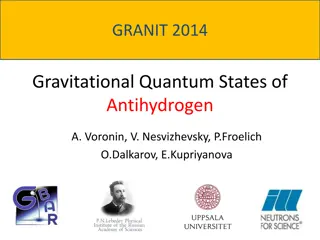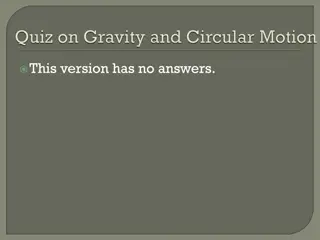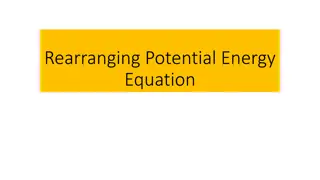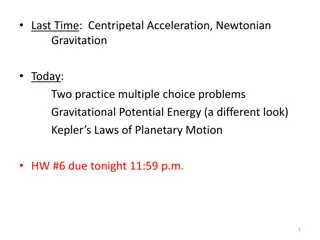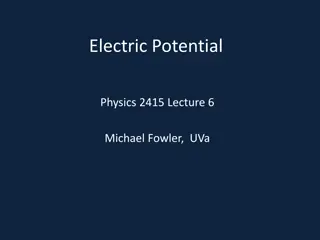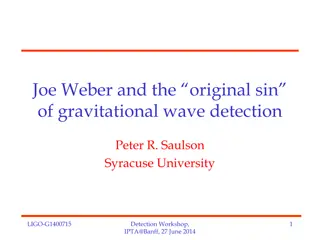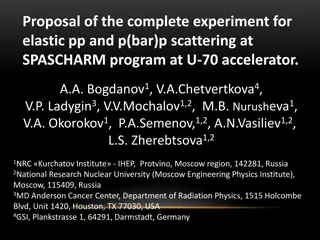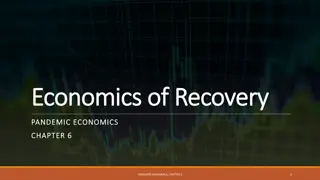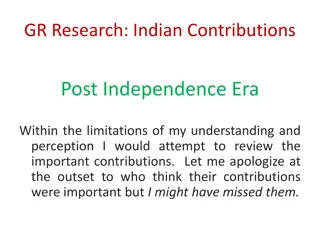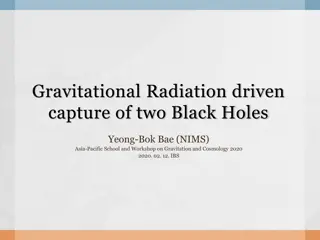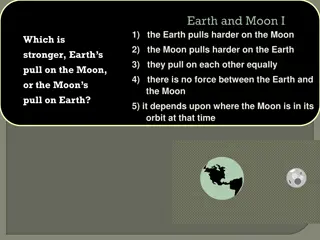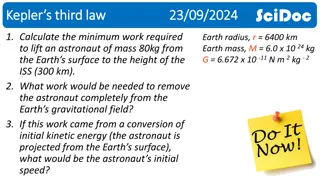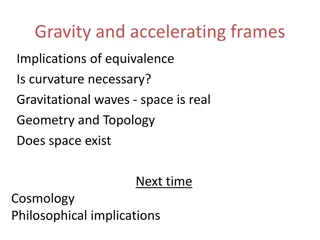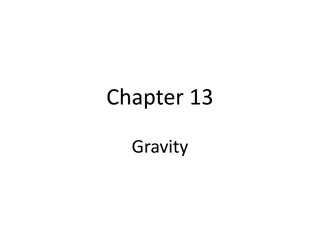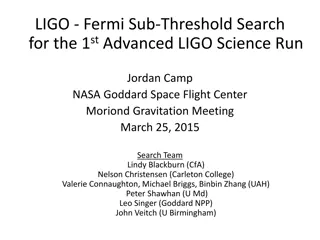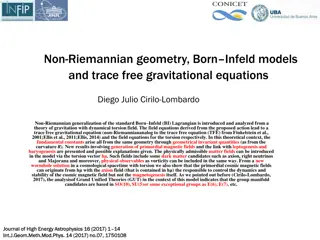Regional Recovery of Disturbing Gravitational Potential from GOCE Observables
Collaboration with ESA on regional recovery of the disturbing gravitational potential from GOCE observables, focusing on motivation, theoretical background, numerical experiments, results, and conclusions. The project aims to enhance the accuracy of regional gravity field data in Europe using EGG data and analyze the impact of different time spans on final results.
- Gravitational potential
- Regional recovery
- GOCE observables
- ESA collaboration
- Geophysical exploration
Download Presentation

Please find below an Image/Link to download the presentation.
The content on the website is provided AS IS for your information and personal use only. It may not be sold, licensed, or shared on other websites without obtaining consent from the author. Download presentation by click this link. If you encounter any issues during the download, it is possible that the publisher has removed the file from their server.
E N D
Presentation Transcript
Regional recovery of the disturbing gravitational potential from GOCE observables Martin Pito k1, Michal prl k2 and Pavel Nov k1 1New Technologies for Information Society, Faculty of Applied Sciences, University of West Bohemia, Plze , Czech Republic 2School of Engineering and Built Environment, University of Newcastle, Callaghan, NSW 2308, Australia 10 YEARS OF THE CZECH REPUBLIC IN ESA, November 12 - 15, 2018, Prague
Content: Colaboration with ESA Motivation, Theoretical background, Numerical experiment, Results, Conclusion and discussion Pito k et al. Regional recovery of the disturbing gravitational potential from GOCE observables 1/20
Colaboration with ESA (1/4 ): ESTEC Project 4000103566/11/NL/FvO/ef Towards a Better Understanding of the Earth s Interior and Geophysical Exploration Research GOCE-GDC GOCE+ GeoExplorefunded by ESA through the Support To Science Element STS Pito k et al. Regional recovery of the disturbing gravitational potential from GOCE observables 2/20
Colaboration with ESA (2/4): More information and details on the website http://goce.kma.zcu.cz/ Pito k et al. Regional recovery of the disturbing gravitational potential from GOCE observables 3/20
Colaboration with ESA (3/4 ): Please visit the website: https://earth.esa.int/web/guest/missions/es a-operational-eo-missions/goce/geoexplore Pito k et al. Regional recovery of the disturbing gravitational potential from GOCE observables 4/20
Colaboration with ESA (4/4 ): Projects publications Pito k et al. Regional recovery of the disturbing gravitational potential from GOCE observables 5/20
Motivation: The GOCE mission - more than three years of outstanding measurements which resulted into five releases of global gravitational models (GGMs), Comparisonof two strategies for reduction the far zone effect, How compare results from downward continuation with EGM2008 and quantify the differences? Can we improve regional gravity field in Europe from EGG data? How various time-span of the EGG data influence accuracy of the final results? Pito k et al. Regional recovery of the disturbing gravitational potential from GOCE observables 6/20
Theoretical background (1/2): Integral transformation The relationship between the disturbing gravitational gradients and the disturbing gravitational potential can be obtained by differentiating the spherical Abel-Poisson integral formula ( prl k et al., 2015) ( ) 1 R = = ij ( , ) ij T r T R , K ( , ) d t u , , i j , , , (1) x y z 4 2 IRF Inertial Reference Frame The corresponding integral kernel functions were derived by (ibid.) EFRF Earth Fixed Reference Frame = = = = + xx 0* 2* K ( , , ) t u K ( , ) cos2 t u K ( , ), t u LNOF Local North Oriented Frame xz 1* K ( , , ) cos t u K ( , ), t u GRF Gradiometer Reference Frame yy 0* 2* K ( , , ) t u K ( , ) cos2 t u K ( , ), (2) t u zz 0* K The isotropic kernel functions in the previous equations are (ibid.) ( , ) t u 2 K ( , ). t u 3 2 t g 3 (1 t t ) tu = 1 5 + (1 3 ) tu + + + + ) 5 0* 2 2 2 2 K ( , ) t u t t 2 (1 u t t , 5 2 2 g 4 2 3 t 1 g u 1 g = + + (1 3 ) tu + 1* 2 2 2 2 K ( , ) t u 1 t 2 t (7 t ) t , (3) 5 2 5 15 2 t ( ) = 2* 2 2 K ( , ) t u 1 t (1 u ). 7 g The nomenclature which was used in the previous equations = = ( , + u u ) sin sin cos cos cos( ), = = = + 2 t R r R r g , , ( , ) g t u 1 2 tu t . Pito k et al. Regional recovery of the disturbing gravitational potential from GOCE observables 7/20
Theoretical background (2/2): Regularization Eq. (1) in the vector-matrix form well-known as the Gauss-Markov model = + l Ax for the least-squares estimate of x we can write , (4) ( ) 1 x = = T T 1 T A PA A Pl N A Pl . (5) The system of normal equations (5) represents the discretized Fredholm integral equation of the first kind with the ill-conditioned matrix of normal equations N (its condition number in numerical experiments reached values 1016). The Tikhonov regularization (Tikhonov 1963a, b) with the estimate of x in the following form was applied ( ) ( ) 1 1 x = + = + T 2 T 2 T A PA I A Pl N I A Pl . (6) reg In our numerical experiments we applied the general cross-validation (GCV) method (Hansen and O Fleary, 1993) and L-curve criterion (Miller, 1970) to determine regularization parameter. The bias of the solution can formally be computed from (Xu et al., 2006) ( ) 1 b x = + = 2 2 N I x x , . (7) b bc reg Combination of all four well-measured gravitational gradients: The Tikhonov regularization (Eq. 6) ( reg = + x A PA I Variance Component estimation (Koch and Kusche, 2002) ) ( ) ( A P l ) 1 1 = + T 2 T 2 T A Pl N I A Pl + + + + = T xx T yy T zz T xz A P A A P A A P A A P A P x xx xx yy yy zz zz xz xz = ]T l [ l l l l + + + T xx T yy T zz T xz A P l A P l A P l . xx yy zz xz xx xx yy yy zz zz xz xz 2 xx 2 xx 2 xx 2 2 = ]T A [ A A A A = = = = weighting parameters - , , regularization parameter, xx xx yy zz xz 2 yy 2 zz 2 xz Pito k et al. Regional recovery of the disturbing gravitational potential from GOCE observables 8/20
Numerical experiment (1/4): Test area and input data Input data: GOCE Level 2 EGG_TRF_2 (1 November 2009 to 30 June 2010) 8 months 35 ;60 , 10 ;40 ( 354000 values for each gravitational gradient) 39.96 ;55.08 , 0.36 ;29.88 , = = 0.72 Solution area: = 5 Integration radius: 0 Pito k et al. Regional recovery of the disturbing gravitational potential from GOCE observables 9/20
Numerical experiment(2/4): Computation scheme Strategy I Strategy II Pito k et al. Regional recovery of the disturbing gravitational potential from GOCE observables 10/20
Numerical experiment(3/4): Strategy I: 1 ( , ) T r = = ij ( , ) T r ( , T R ) ( , ) d K t u , , i j , , , x y z ij ij 2 4 R 0 ij T r ( , ) - the truncation error formulas computed according to ( prl k et al., 2015) up to the degree 150 from the GRACE-based global gravitational model GGM05S (Tapley et al., 2013). Strategy II: Low frequencies of the gravitational field should be removed to reduce the effect of the omitted distant zone data. 1 ( , ) ( , ) ( , ) ( , ) d 4 R 180 250 = = 0 180 ij T ij T r r T R K t u , , i j , , , x y z ij 2 0 The long-wavelength effect was generated from the TIM-r4 model (Pail et al., 2011) up to the degree 180 version a: 30 days (November 2009) of the input data, version b: 72 days (1 November 2009 11 January 2010) of the input data, version c: 212 days (1 November 2009 30 June 2013) of the input data. Pito k et al. Regional recovery of the disturbing gravitational potential from GOCE observables 11/20
Numerical experiment(4/4): Test of the results Spherical harmonic synthesis n N n GM R r r = = ( , ) ( , T R T R = + C S cos( sin( k k ) )) ( ) n k , = ( , T R ) P sin n k , n 2 k 0 n k , ) ( , T R ) DC EGM 2008 Spherical harmonic analysis ( ( ) ) n cos sin k k C S R GM r ( ) n k , = ( , T R ) P sin d n k , 4 R n k , Degree correlation with Rock-Water- Ice topographic-isostatic gravitational model (Grombein et al., 2014) n ( ) + A nk B nk A nk B nk C C S S = = k 0 C ( ) ( ) n 2 n A nk A nk 2 n B nk B nk , S C , S Pito k et al. Regional recovery of the disturbing gravitational potential from GOCE observables 12/20
Results (Strategy I): Differences between the values of the disturbing gravitational potential obtained from Txx, Tyy, Tzzand Txz, as well as from their combination using joint inversion and the VCE method (truncation error reduction) from the 212 day data coverage, and from EGM2008 up to the degree 240 (unit 1 m2s-2) Txx Tyy Tzz Txz Joint inversion 2.971 -18.380 5.568 -1.806 VCE 3.201 -17.737 5.000 -4.859 RMS Min Max mean 22.346 -123.893 4.170 -33.352 24.941 -103.249 35.139 -20.995 8.514 -57.330 1.149 -10.294 74.641 -527.766 -169.314 -356.775 Differences between values of the disturbing gravitational potential from the selected models and EGM2008 up to the degree 240 (unit 1 m2s-2) TIM-r2 1.110 -4.959 2.968 0.002 DIR-r2 1.262 -3.967 3.789 -0.014 SPW-r2 1.485 -8.203 6.432 0.034 RMS min max mean Pito k et al. Regional recovery of the disturbing gravitational potential from GOCE observables 13/20
Results (Strategy II): Differences between the values of the disturbing gravitational potential obtained from Txx, Tyy, Tzzand Txz, as well as from their combination using joint inversion and the VCE method (remove-compute-restore scenario) from the 30, 72 and 212 day data coverage, and from EGM2008 up to the degree 240 (unit 1 m2s-2) 30 days Txx Tyy Tzz Txz Joint inversion 1.805 VCE 1.712 2.055 2.331 2.627 2.626 RMS -11.430 -12.102 -9.054 -10.000 -8.963 -11.573 Min max 8.850 10.583 7.861 8.041 5.123 9.437 mean 0.044 -0.018 0.015 -0.050 0.019 0.014 72 days rms 1.916 2.176 2.041 2.152 1.584 1.497 min -11.882 -12.572 -8.947 -9.062 -8.340 -10.567 max 8.444 10.651 8.136 7.666 6.529 8.215 mean 0.030 0.027 0.034 -0.052 0.023 0.015 212 days rms 1.789 2.015 1.515 1.719 1.326 1.231 min -10.073 -12.317 -9.341 -8.739 -8.326 -7.522 max 7.930 10.769 5.053 5.946 5.166 5.036 mean 0.025 0.021 0.021 -0.030 0.019 0.014 Pito k et al. Regional recovery of the disturbing gravitational potential from GOCE observables 14/20
Results (Strategy I): Degree correlation coefficients between selected GOCE-based global gravitational models, EGM2008, selected regional solutions (GOCE gradient data from November 2009 - June 2010 with truncation error reduction applied) and RWI model. Pito k et al. Regional recovery of the disturbing gravitational potential from GOCE observables 15/20
Results (Strategy II version a): Degree correlation coefficients between selected GOCE-based global gravitational models, EGM2008, selected regional solutions (GOCE data from November 2009 with the remove-compute-restore scenario applied) and RWI model. Pito k et al. Regional recovery of the disturbing gravitational potential from GOCE observables 16/20
Results (Strategy II version b): Degree correlation coefficients between selected GOCE-based global gravitational models, EGM2008, selected regional solutions (GOCE data from 1 November 2009 11 January 2010 with the remove-compute-restore scenario applied) and RWI model. Pito k et al. Regional recovery of the disturbing gravitational potential from GOCE observables 17/20
Results (Strategy II version c): Degree correlation coefficients between selected GOCE-based global gravitational models, EGM2008, selected regional solutions (GOCE data from 1 November 2009 30 June 2010 with the remove-compute-restore scenario applied) and RWI model Pito k et al. Regional recovery of the disturbing gravitational potential from GOCE observables 18/20
Conclusion and discussion: A method for comparing results from downward continuation with EGM2008 was suggested, Our regional models are comparable with the second release of GOCE-based GGMs, More data improved an accuracy of regional models about 0.5 mGal for combined solutions and more than 1 mGal for Tzz , In the future experiment the reprocessed gravitational gradients in the gradiometric reference frame will be applied. NOTHING TO FEAR FROM REAL GRAVITATIONAL GRADIENTS MEASURED BY GOCE GRADIOMETER Pito k et al. Regional recovery of the disturbing gravitational potential from GOCE observables 19/20
Thank you for your attention pitonakm@ntis.zcu.cz Pito k et al. Regional recovery of the disturbing gravitational potential from GOCE observables 20/20



